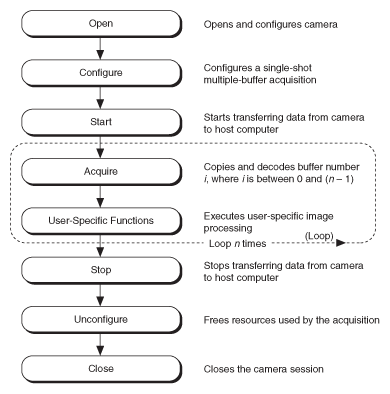Low-Level Function Programming Examples
Use low-level functions for more advanced programming techniques. In general, low-level functions have more parameters than high-level functions.
Low-Level Snap Functions
The low-level snap examples set up a one-shot, single-image acquisition and start the acquisition. The program acquires an image and processes it. Finally, the program stops the acquisition, unconfigures the acquisition, and closes the session.
The following figure illustrates the programming order of a low-level snap acquisition.

Low-Level Grab Functions
The low-level grab examples demonstrate how to perform a grab acquisition using low-level function calls. The program sets up a continuous acquisition into three internal buffers and starts the acquisition. The main loop iterates continuously. In the main processing loop, the program acquires an image and processes it. After the loop, the program stops the acquisition, unconfigures the acquisition, and closes the session.
The following figure illustrates the programming order of a low-level grab acquisition.

Low-Level Sequence Functions
The low-level sequence examples demonstrate how to perform a sequence acquisition using low-level calls. The program sets up a one-shot, multi-image acquisition and starts the acquisition. The main loop iterates once for each internal buffer. In the main processing loop, the program acquires an image and processes it. After the loop, the program stops the acquisition, unconfigures the acquisition, and closes the session.
The following figure illustrates the programming order of a low-level sequence acquisition.
